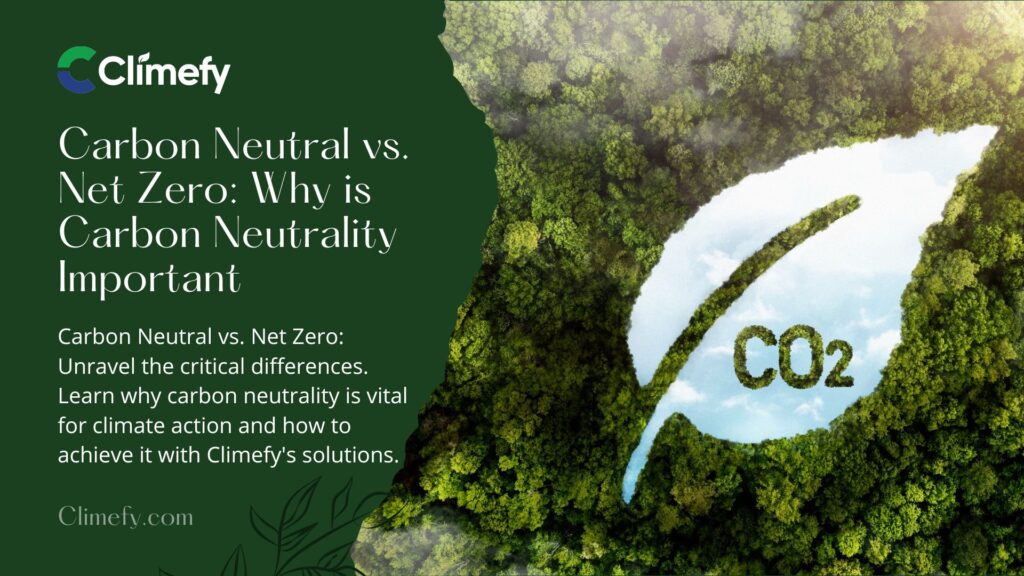

Carbon neutrality represents a critical milestone in the global fight against climate change, serving as a foundational step towards the more ambitious goal of a net zero world. While these terms are often used interchangeably, understanding their distinct meanings, scopes, and implications is essential for any credible climate strategy. This comprehensive guide will demystify these concepts, explore their significance, and provide a clear roadmap for individuals and businesses seeking to take meaningful climate action, ultimately highlighting the role of innovative platforms like Climefy in facilitating this essential transition.
In this definitive guide, you will learn:
Read More:

The terms “carbon neutral” and “net zero” are pillars of modern climate discourse, yet their nuanced differences are crucial for setting accurate and effective emissions targets. At its core, the distinction lies in the scope and type of emissions being addressed and the long-term temperature implications for the planet.
Carbon Neutrality is achieved when an entity’s carbon dioxide (CO₂) emissions are balanced by an equivalent amount of CO₂ removed from the atmosphere. This is often accomplished through the purchase of carbon offsets that fund projects which avoid or reduce emissions elsewhere. The focus is primarily on compensating for the carbon dioxide emissions that an organization is directly responsible for.
Net Zero Emissions is a more comprehensive and ambitious target. It requires reducing all greenhouse gas (GHG) emissions (including CO₂, methane, nitrous oxide, and fluorinated gases) to as close to zero as possible. Any residual emissions that are technically impossible to eliminate must then be balanced by permanent removals of carbon from the atmosphere. The ultimate goal of net zero is to stop humanity’s contribution to the increase of global warming.
To clarify the key distinctions, consider the following comparative analysis:
The journey for a corporation often begins with understanding its carbon footprint using a robust carbon calculator for large organizations, which provides the foundational data needed to strategize. From there, the path typically progresses from carbon neutrality as a near-term target to net zero as the long-term, science-aligned ambition.
Carbon neutrality is a state of balance—a equilibrium between the amount of carbon dioxide released into the atmosphere and the amount withdrawn or offset. For an individual, company, or nation, it means that their net carbon contribution is zero. This does not imply that they emit no carbon, but rather that for every ton of CO₂ they emit, they ensure a ton is compensated for through verified mechanisms.
The process of achieving and verifying carbon neutrality is methodical and data-driven. It follows a clear cycle of measurement, reduction, and compensation.
Accurate measurement is the bedrock of this entire process. Tools like the carbon calculator for small & medium companies demystify this initial phase, allowing businesses to gain immediate insight into their environmental impact and lay the groundwork for a credible carbon neutral claim.
The push for carbon neutrality is not merely a corporate trend; it is an urgent environmental and economic imperative rooted in established climate science. Its importance is multifaceted, addressing the core driver of global climate disruption and unlocking a cascade of co-benefits.
For businesses, embarking on a net zero journey is no longer a niche differentiator but a core component of long-term resilience and competitiveness. Platforms like Climefy provide the essential digital integration solutions that embed carbon accountability into the very fabric of business operations, making sustainability a seamless and scalable endeavor.
The path to carbon neutrality is a structured process that transforms an organization’s relationship with its carbon footprint. It requires commitment, transparency, and a willingness to integrate sustainability into core business strategy. Here is a detailed, actionable guide for any entity aiming to achieve this critical status.
The journey begins with a public, top-level commitment. This involves securing buy-in from leadership and stakeholders to allocate necessary resources. The organization should formally announce its intention to become carbon neutral and set a realistic yet ambitious target date for achievement.
You cannot manage what you cannot measure. This step involves conducting a rigorous carbon footprint assessment across all three scopes. For small businesses, starting with the carbon calculator for small & medium companies is an excellent first step. Large corporations will require a more granular analysis, often facilitated by specialized software and ESG consultancy services to ensure compliance with international standards like the GHG Protocol.
Offsetting is a last resort; the primary focus must be on absolute emission reductions. This step involves creating a detailed action plan to decarbonize operations. Key initiatives often include:
After implementing all feasible reductions, the remaining emissions must be neutralized through the purchase of high-quality carbon offsets. This is a critical step where credibility is paramount. Organizations should prioritize carbon credits from verified projects that adhere to rigorous standards, such as the Climefy Verified Carbon Standard. These projects can be sourced through Climefy’s Marketplace for GHG reduction projects, which offers a curated selection of verified initiatives in areas like afforestation and plantation and renewable energy.
Transparency is key to credibility. Publicly report your progress, methodologies, and the details of the offsets you’ve retired. Seek third-party verification of your carbon footprint and offsetting claims to assure stakeholders that your carbon neutral status is legitimate and not an example of greenwashing.
Carbon neutrality is not a one-time event but an ongoing cycle. Annually reassess your carbon footprint, update your reduction strategies, and continue offsetting residual emissions. The ultimate goal is to continuously reduce the amount you need to offset, progressively moving closer to a net zero state.
Carbon offsets are the essential mechanism that makes carbon neutrality feasible for entities that cannot yet eliminate all their emissions. They function as a unit of exchange in the voluntary carbon market, representing a verified reduction or removal of one metric ton of CO₂ equivalent from the atmosphere.
The voluntary carbon market is a system where these carbon credits are bought and sold by companies, governments, and individuals to compensate for their emissions voluntarily. The integrity of this entire system hinges on the quality of the carbon credits, which is determined by several key principles:
High-quality offset projects can be categorized into two main types:
For an organization looking to make a credible impact, navigating this market can be complex. Platforms like Climefy’s Marketplace simplify this by vetting projects against high standards, allowing businesses to invest confidently in projects that deliver tangible environmental and social benefits, thereby solidifying their status as an eco-friendly partner.
While carbon neutrality is a commendable and necessary achievement, it is a stepping stone, not the final destination. The scientific consensus is clear that to stabilize the climate, the world must achieve net zero emissions for all greenhouse gases. The concept of Net Zero expands upon carbon neutrality in several critical ways, demanding a more profound systemic transformation.
The core distinction, as previously mentioned, is the inclusion of all greenhouse gases and the emphasis on deep decarbonization before compensation. The path to net zero is therefore more rigorous and can be broken down into a set of core principles:
Reaching net zero is a monumental challenge that requires collaboration across industries, governments, and civil society. It involves transitioning entire energy systems, redesigning supply chains, and developing new, clean industrial processes. For businesses, this journey is complex but navigable with the right expertise.
Engaging with a partner that offers a comprehensive net zero journey program can provide the strategic guidance, data management tools, and project development support necessary to turn this ambitious goal into an actionable reality, ensuring that their climate actions are both credible and impactful.
Think of it in terms of a bathtub. Carbon Neutrality is like turning off the tap (your emissions) but using a cup to remove some water to balance out the initial splash. You’ve stopped adding more, but you’re dealing with the water already in the tub. Net Zero is not only turning off the tap completely but also pulling the plug to drain the tub, addressing the root cause of the overflow. Net zero focuses on stopping the flow of all greenhouse gases and then removing the residual buildup.
Yes, absolutely. Many companies achieve carbon neutrality as an interim goal on their path to net zero. A company can be carbon neutral by offsetting its current carbon emissions, even if it hasn’t yet achieved the deep, across-the-board reductions required for net zero. Carbon neutrality is a vital first step that demonstrates commitment and builds the framework for the more demanding net zero transition.
No, when done correctly, it is not. High-quality carbon offsetting is a critical part of the climate solution, but it must be a last resort, not a first option. The correct approach is “Measure, Reduce, Then Offset.” A company must first demonstrate a serious and ongoing effort to reduce its own emissions. Offsets should only be used for the remaining, unavoidable emissions. Furthermore, purchasing high-integrity credits finances essential projects that reduce emissions or remove carbon elsewhere, accelerating the global transition.
Look for transparency and third-party verification. A credible claim should be backed by a public report that details:
The methodology used for calculating the carbon footprint (e.g., GHG Protocol).
A clear breakdown of Scope 1, 2, and 3 emissions.
The specific carbon reduction initiatives implemented.
The source and certification standard of the carbon offsets purchased (e.g., Climefy Verified Carbon Standard).
Verification from an independent, accredited third-party auditor.
The primary challenges include:
Accurate Data Collection: Gathering complete and accurate data, especially for Scope 3 value chain emissions, is complex.
Cost of Implementation: Upfront investments in energy efficiency, renewable energy, and new technologies can be significant.
Navigating the Carbon Market: Identifying and purchasing high-quality, verifiable carbon offsets from a legitimate carbon offset registry can be daunting without expert guidance.
Organizational Buy-in: Securing commitment and budget from all levels of the organization requires strong leadership and a clear business case.
Begin by using a carbon calculator for individuals to understand your primary sources of emissions. Common high-impact actions include:
Reducing air travel and driving, opting for public transport or cycling.
Switching to a green energy tariff for your home.
Reducing consumption of meat and dairy.
Improving home energy efficiency (insulation, efficient appliances).
Minimizing waste and embracing a circular economy mindset (repair, reuse, recycle).